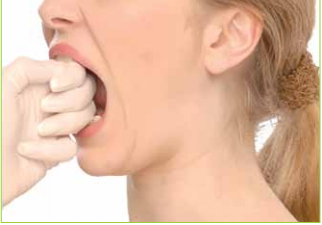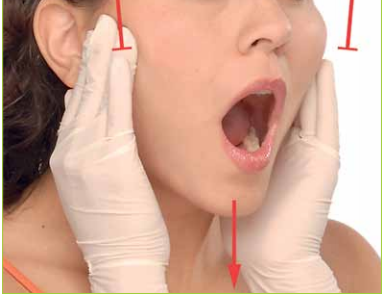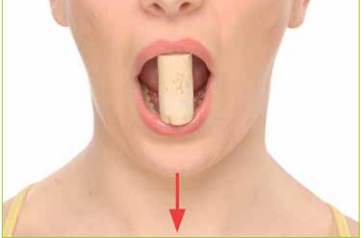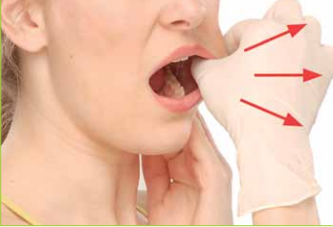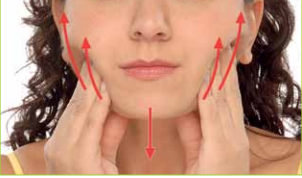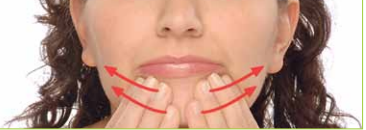Masticatory muscle stretching techniques.
The stretching techniques of MimiLift Facial MuscleCare aim to regain and maintain the optimal length of the masticatory muscles.
Proper stretching improves healthy range of motion in the lower jaw and relieves tension and pain caused by tight chewing muscles.
Jaw opening test
The maximum opening of the mouth and lower jaw in most individuals is greater than 40mm.
1. Dynamic stretching of the masticatory muscles:
Press your fingers firmly under your zygomatic arch.
Slowly lower your jaw as far as it will go while pressing your fingers very firmly against the skin and pushing up the soft tissues of the masseter muscle and zygomatic arch area.
Hold this position for 5 seconds. Gradually return to the starting position.
Repeat 5 times.
HEALTH IMPACT: Relaxes and lengthens the closing masticatory muscles of the jaw, especially the masseter muscle.
Strengthens the muscles that open the jaw.
APPEARANCE IMPACT: Lifts the cheek area.
2. Intensive stretching of the masticatory muscles:
Gently and carefully place a cork or something similar of an appropriate size and safe material between your teeth.
Relax. Hold the stretch for 20-30 seconds and repeat the stretch 4 times. You can stretch even longer, but the maximum time to hold each stretch is one minute.
HEALTH IMPACT: This is an important stretch to lengthen all the closing chewing muscles of the jaw and increase the opening of the jaw. Helps with speech and swallowing.
3. Stretch the chewing muscles from the inside of the mouth.
Put your thumb in your mouth. Push the cheek outward with your thumb. Push the cheek with your thumb alternately diagonally downward, straight to the side and diagonally upward.
HEALTH IMPACT: This manually assisted stretch effectively relaxes and lengthens the closing masticatory muscles of the jaw in the cheek area, primarily the masseter muscle.
APPEARANCE IMPACT: Relaxed chewing muscles in the cheeks will give the cheeks the appearance of youthful plumpness.
4. Technique of stretching the temporalis muscle.
In order to increase the feeling of stretching in your temporal area, you can move your jaw to the side during the stretch or tilt your head to the side or down towards your chest.
HEALTH IMPACT: Releases tension in the temporal muscle. Promotes a relaxed and optimal resting position of the jaw.
Massage for the masticatory muscles.
Massage reduces tension, pain and tightness in chewing muscles. It relaxes the chewing muscles in a pleasant way and promotes a feeling of general well-being.
1. Longitudinal massage stroke for the masseter muscle.
Press your fingers on the angle of the jaw. Push the fingers very firmly and slowly upward along the masseter muscle.
This sliding massage movement continues up to the zygomatic arch.
Open your jaw as the massaging movement takes place. Repeat the massage movement 6 times.
HEALTH IMPACT: Relaxes the chewing muscles of the jaw. Relieves tension and pain in the masseter muscle. Activates the muscles that open the jaw.
IMPACT ON APPEARANCE: Lifts the cheek area.
2. Transverse massage stroke for the masseter muscle.
The massage movement slides over the masseter muscle and also over the mimetic muscles of the lower face.
Maintain firm pressure. Extend the lips as the fingers move towards the angle of the jaw.
The first shot goes near the jaw line. Make the next stroke slightly higher, starting closer to the corners of your mouth.
Repeat the massage movements a total of 6 times.
HEALTH IMPACT: Relaxes the masseter muscle as well as the mimic muscles of the lower face.
3. Gliding and friction strokes for the temporalis muscle.
Spread your fingers slightly apart and place your fingers on the side of your head, near your ear.
Pressing firmly, slowly slide your fingers along the temporalis muscle alternately upward and diagonally upward and backward.
Keep your jaw a little open during the gliding motion. Repeat the massage movements a total of 6 times.
Cover the entire temporalis muscle with the sliding movements.
Do the same massage on the other side of your head.
Apply firm circular pressures to the side of your head.
Your fingers do not slide over the muscle but
move and loosen the temporalis muscle.
Repeat the massage on the other side of your head.
HEALTH IMPACT: Relieves tension headaches.

